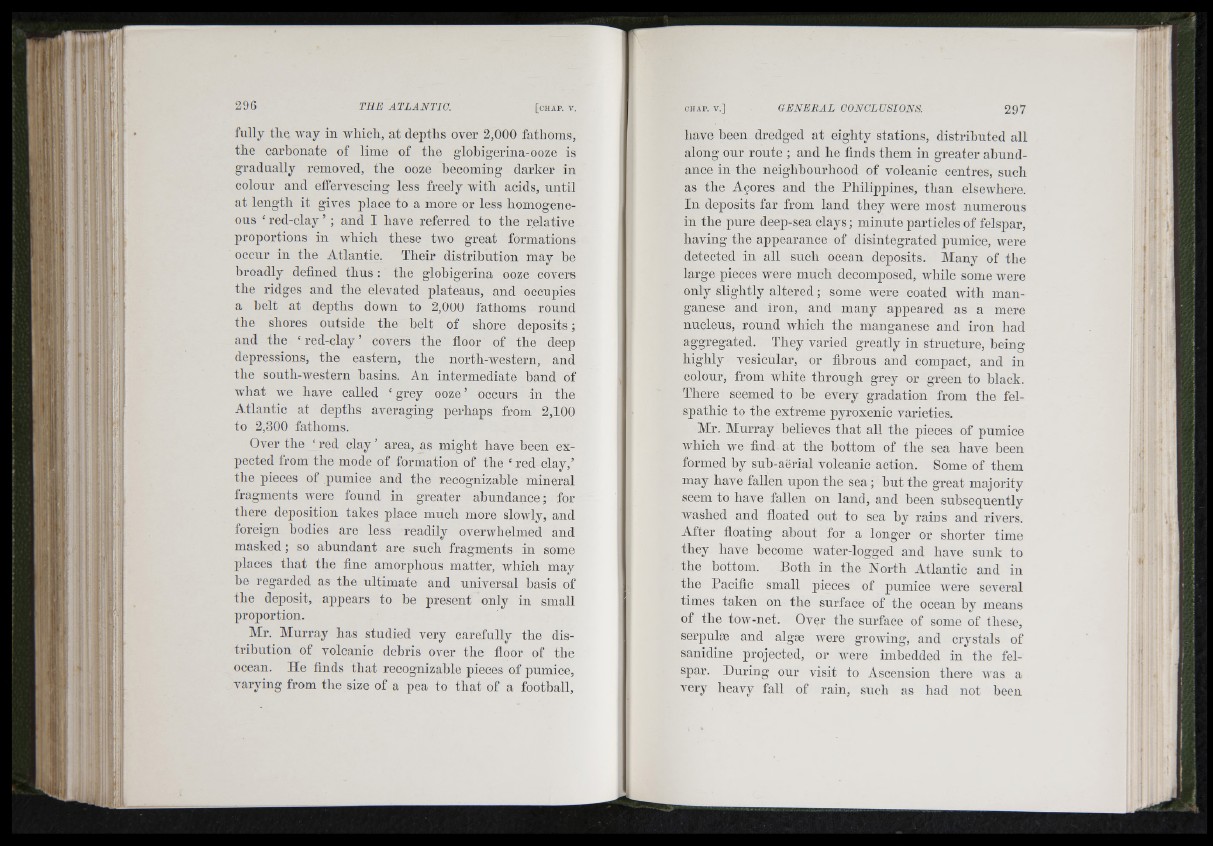
t
h -
m
sü ..I
îJïi:i:î; ! iilp L' üHiüii
ï
II 1 M»
il
ÎK
i'iî
fully the way in AA'hich, at depths over 2,000 fathoms,
the carbonate of lime of tbe gdobigerina-ooze is
gradually removed, tbe ooze becoming darker in
colour and effervescing less freely with acids, until
at length it gives place to a more or less homogeneous
‘ red-clay ’ ; and I have referred to the relative
proportions in Avhich these tAVO great formations
occur in the Atlantic. Their distribution may be
broadly defined thus : tbe globigerina ooze covers
tbe ridges and tbe elevated plateaus, and occupies
a belt at depths down to 2,000 fathoms round
tbe shores outside tbe belt of shore deposits;
and tbe ‘ red-clay ’ covers tbe floor of the deep
depressions, tbe eastern, tbe north-Avestern, and
tbe south-western basins. An intermediate band of
Avliat Ave have called ‘ grey ooze ’ occurs in tbe
Atlantic at depths averaging perhaps from 2,100
to 2,300 fathoms.
Over tbe ‘ red clay ’ area, as might have been expected
from tbe mode of formation of tbe ‘ red clay,’
tbe pieces of pumice and the recognizable mineral
fragments Avere found iu greater abundance; for
there deposition takes place mucb more slowly, and
foreign bodies are less readily overwhelmed and
masked; so abundant are such fragments in some
places tb a t the fine amorphous matter, Avhich may
be regarded as tbe ultimate and universal basis of
tbe deposit, appears to be present only in small
proportion.
Mr. Murray has studied very carefully the distribution
of volcanic debris over the floor of tbe
ocean. He finds tbat recognizable pieces of pumice,
varying from tlie size of a pea to that of a football.
have been dredged at eighty stations, distributed all
along our route ; and he finds them in greater abundance
in the neighbourhood of volcanic centres, snch
as the Açores and the Philippines, than elscAvhere.
In deposits far from land they Avere most numerous
in the pure deep-sea clays ; minute particles of felspar,
having the appearance of disintegrated pumice, were
detected in all such ocean deposits. Many of tlie
large pieces were much decomposed, while some Avere
only slightly altered ; some AA'ere coated Avith manganese
and iron, and many appeared as a mere
nucleus, round which the manganese and iron had
aggregated. They varied greatly in structure, being
highly vesicular, or fibrous and compact, and in
colour, from Avhite through grey or green to black.
There seemed to he every gradation from the fel-
spathic to the extreme pyroxenic varieties.
Mr. Murray believes tb a t all tbe pieces of pumice
Avbicb we find at tbe bottom of tbe sea bave been
formed by sub-aerial volcanic action. Some of them
may bave fallen upon tbe sea ; but tbe great majority
seem to bave fallen on land, and been subseqnentlv
Avasbed and floated out to sea by rains and iHers.
After floating about for a longer or shorter time
tbey bave become Avater-logged and bave sunk to
tbe bottom. Botb in tbe Nortb Atlantic and in
tbe Pacific small pieces of pumice Avere several
times taken on tbe surface of tbe ocean by means
of tbe toAv-net. Over tbe surface of some of tbese,
serpulæ and algæ Avere groAA’ing, and crystals of
sanidine projected, or Avere imbedded in tbe felspar.
During our visit to Ascension tbere Avas a
very beavy fall of rain, sncb as bad not been